IFC releases report, highlighting SolTuna
Disclaimer : IFC, a member of the World Bank Group, creates opportunity for people to escape poverty and improve their lives. We foster sustainable economic growth in developing countries by supporting private sector development, mobilizing private capital, and providing advisory and risk mitigation services to businesses and governments. This report was commissioned by IFC’s Manufacturing, Agribusiness and Services Department in partnership with IFC’s Gender Secretariat, which works with IFC clients to reduce gaps in economic opportunity between women and men in the private sector while enabling companies and economies to improve their performance. For more information about IFC’s gender work, please visit www.ifc.org/gender.
IFC does not guarantee the accuracy, reliability or completeness of the content included in this work, or for the conclusions, or judgments described herein, and accepts no responsibility or liability for any omissions or errors (including, without limitation, typographical errors and technical errors) in the content whatsoever or for reliance thereon. The boundaries, colors, denominations, and other information shown on any map in this work do not imply any judgment on the part of the World Bank Group concerning the legal status of any territory or the endorsement or acceptance of such boundaries.
The findings, interpretations, and conclusions expressed in this volume do not necessarily reflect the views of the Executive Directors of the World Bank Group or the governments they represent.
All other queries on rights and licenses, including subsidiary rights, should be addressed to IFC Communications,
2121 Pennsylvania Avenue, N.W., Washington, D.C. 20433.
International Finance Corporation is an international organization established by Articles of Agreement among its member countries, and a member of the World Bank Group. All names, logos and trademarks are the property of IFC and you may not use any of such materials for any purpose without the express written consent of IFC. Additionally, “International Finance Corporation” and “IFC” are registered trademarks of IFC and are protected under international law.
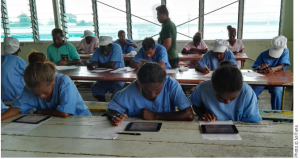
Company Background
SolTuna, based in the town of Noro in Solomon Islands’ Western Province, is the country’s only tuna processing facility. An IFC investment client since 2013, SolTuna employs over 1,800 workers, 64% of whom are women.
SolTuna is a significant private-sector employer in Solomon Islands, a country with a population of 540,000, spread across more than 1,000 islands, and covering an area of over 28,000 square kilometers. The country experienced violent ethnic conflicts from 1998 to 2003. The Australian-led Regional Assistance Mission to Solomon Islands (RAMSI) has been stationed in Solomon Islands since the end of the conflict, but is expected to leave in 2017. The conflict left the country with very low public-sector administrative capacity, and its health and education systems with serious deficiencies.
Solomon Islands is a lower middle-income country with a GNI per capita of 1,800 PPP dollars. The tuna industry accounts for 18% of Solomon Islands’ GDP. In addition to SolTuna, the other major private-sector employers include a palm-oil plantation, various forestry operations, the banking sector, retail, and a small but growing tourism industry. However, the vast majority of the working population are found in informal businesses. Of those formally employed, the public sector accounts for 20%.
Most of SolTuna’s output is exported as tuna loins to the European Union. SolTuna also sells a substantial amount of canned tuna domestically, significantly contributing to food security in Solomon Islands.
SolTuna’s comparatively small size and its remote location in a lower middle-income, post-conflict country present the company with significant operational and cost-management challenges. Many of these challenges are common to the other small tuna producers based in the Pacific Islands, such as Papua New Guinea. All Pacific Islands producers are disadvantaged in comparison to major tuna processors in Southeast Asia – primarily Thailand and the Philippines – in regard to the availability of relatively cheap and productive labor. Pacific island producers also face relatively high energy costs, inconsistent fresh water supply, relatively high-cost and less available shipping, and poorer supporting infrastructure. However, the company does benefit from access to large and plentiful fishing grounds in Solomon Islands’ territorial waters.
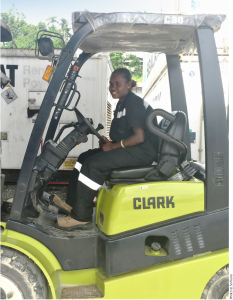
HOW THE COMPANY IS ADDRESSING GENDER ISSUES
SolTuna has a strong commitment to ensuring equal rights and opportunities for women and men in the workplace. Non-discrimination policies and practices are in place, and the company has taken proactive steps to support women workers and promote greater gender equality through initiatives such as investing in training women Forklift Training Systems drivers and supporting community efforts to address gender-based violence (GBV).
Nonetheless, the company is operating in an environment of severe gender inequality, where businesses face considerable challenges in attracting and retaining the female human resources they need to operate and grow their business. There are significant inequalities in men’s and women’s economic opportunities in Solomon Islands. Men are more than twice as likely as women to hold a wage job in the formal sector (23% men compared to 9% women nationally). Unequal sharing of household responsibilities and other unpaid labor is also a major contributor to inequalities between women and men.
Solomon Islands also has one of the highest levels of GBV in the world: almost two-thirds (64%) of women aged 15-49 report having experienced physical or sexual violence by an intimate partner. Women who hold a wagepaying job are just as likely reported to https://paultolandlaw.com/drug-crimes/ to have experienced violence as those who do not.
In this context of gender inequality and relative labor scarcity, the challenges faced by women translate directly into challenges for business, including at SolTuna. Employee retention and consistent attendance at work is a key competitive issue. The company has implemented a number of measures to support women workers and plans to do more. IFC has supported the company in these efforts with an advisory project to further analyze genderrelated issues, and provide guidance on appropriate and effective measures to address them.
FINANCIAL LITERACY TRAINING
Employment at SolTuna is the first formal job for many workers, who are likely to have come from subsistence agriculture and informal work. Many workers have low levels of literacy and numeracy. In addition, most employees support numerous extended family members. All of these factors make it difficult for workers to effectively manage their money. In order to get cash for immediate needs, for example, some forego a significant attendance bonus by selling in the market, instead of working their shift at SolTuna.
Recognizing this, SolTuna worked with a World Bank Group-funded project, Training Women In SolTuna (TWIST) to offer financial literacy and other life-skills training. Between November 2015 and April 2016, six modules of financial literacy, life-skills, and gender training were delivered to nearly 300 production workers at SolTuna, 75% of whom were women (consistent with the relative composition of the production department).
The training contributed to significant improvements in financial attitudes and behavior, as well as an increase in staff attendance at work:
- The proportion of workers reporting that they ‘always’ had money left the day before payday increased by 120%, from 14% at baseline to 31% at the end of the training.
- There was an 81% increase in workers having a savings goal.
- The proportion of workers reporting they made a household budget more than tripled, from 12% at baseline to 39% at completion of the training.
- Absenteeism among trainee participants reduced from 19% on average before the training, to 13% after the training.
Workers also learned how to communicate with their partners and family members about money. During the sessions on banking, borrowing, and lending, the local branch of Solomon Islands’ largest bank, Bank South Pacific, set up tables to help workers open savings accounts. Almost all workers already receive their fortnightly pay into a bank account, and SolTuna regularly arranges for local banks to come to the plant so new workers can set up bank accounts. This helps keep women’s earnings safe from being ‘taken’ by their husbands or male relatives in a context where women often fear being seen as ‘greedy’ or ‘selfish’ – or made an outcast among their extended families – if they do not share their earnings with relatives.
In addition to the measured changes in understanding and behavior related to financial management, many workers shared stories of positive impact on their lives (see box below).
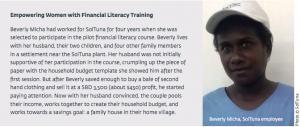
A key aspect of the training is helping workers understand their paychecks and drawing the link between the number of days they show up to work and how much they are paid. A session on reading pay slips goes over how to calculate overtime at time and one-half, double time, and triple time. Overtime is quite common for production workers, particularly during night shifts when staff continue working until tuna thawed that day has been processed. Overtime pay makes up a meaningful proportion of total take-home pay for many workers, so understanding how it is calculated is important to ensure that staff remain motivated when working overtime.
There is also curriculum on the SolTuna incentive-payment scheme, which rewards workers with perfect attendance during the four-week incentive period with an extra day’s pay. An even larger bonus – up to six full days’ extra pay – is possible when workers reach a series of plant-level productivity and efficiency targets. This bonus is only available to workers who are absent for one day or less. Evidence from labor-intensive garment manufacturing in East Asia indicates that workers’ understanding and trust on how they are paid is a key contributor to both well-being and productivity (Brown et al, 2014).
EFFECTIVE WORKER–MANAGEMENT COMMUNICATION
The SolTuna Employees Consultative Committee (SECC) was formed in 2014. The SECC has ten members: four women and six men, with representatives from each department. The SECC has played a pivotal role in keeping communication lines open between management and workers. A notable success in early 2016 was an agreement to spend the 5% wage-bill increase approved by the Board of Directors on raises for the lowest-earning three grades, mostly low-skill production workers. Remaining employees would have a wage freeze for the year.
In addition to the SECC, SolTuna has a number of committees with representatives of workers and managers to discuss key issues and policy decisions, such as the Disciplinary Committee that reviews decisions by the HR manager regarding employee misconduct. Another is the Occupational Safety and Health Employee Implementation team, which works with the technical committee and policy team to implement safety and health measures.
Another committee that has been particularly active in improving opportunities for women is the Housing Committee, which is responsible for allocating and overseeing the sought-after company-provided housing. In 2013, it came to the attention of management that male staff members were far more likely than female workers to have access to housing. SolTuna sought to correct the imbalance by establishing a committee with a female chair, and men and women members, as well as adding gender balance as a criterion for housing allocation. Of the 128 housing units, women employees now have 42.
WOMEN IN NON-TRADITIONAL POSITIONS
The Production and Maintenance & Engineering departments at SolTuna had been actively seeking female recruits and apprentices for some time. They were able to hire a woman mechanic, but failed to get an adequate supply of female apprentices or applicants for other jobs they advertised. In August 2015, management took the initiative to identify and train 10 female staff from the production lines to become forklift drivers.
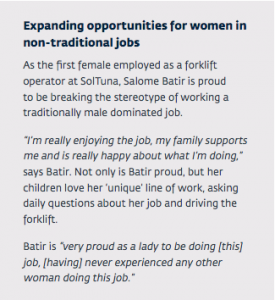
The women volunteered for the training, via a selfnomination process from across the production department, and were then selected by SolTuna management. The training was delivered by a New Zealand-registered training provider on-site at SolTuna. Following the training, the women participated in practice sessions on weekends led by current SolTuna forklift drivers. Within a few months of completing the training, two women have been promoted to full-time positions as forklift drivers (see box on page 7). The women who completed the training were extremely appreciative that SolTuna had provided the opportunity to learn a new skill, opening up a new and much more lucrative and rewarding career path. They and their families demonstrated great pride in the achievement of becoming qualified forklift drivers. Other female production workers also expressed a desire to complete the training and have the opportunity to work in a job such as forklift driving.
Reaching these women, and expanding the current pipeline of female talent in non-traditional roles, is helping ensure SolTuna, “becomes a long-term sustainable business, supporting the local community and provincial economy, and significantly boosting job opportunities in our community” says General Manager, Jim Alexander.
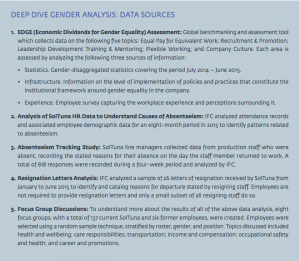
GENDER DIAGNOSTIC
To understand what more they could do to attract, retain, and engage women workers, SolTuna launched a comprehensive diagnostic project with IFC in mid-2015.
The key objectives of the project were the following:
1. Understand root causes of absenteeism and turnover among production staff, and propose solutions.
2. Identify opportunities to benefit from greater gender equality, including:
a) Supporting emerging women leaders to move into management roles.
b) Implementing a structured approach to address GBV involving employees.
c) Improving access to jobs for women in non-traditional roles.
3. Improve financial literacy, household budget management, and life-planning skills of employees.
The project began with a thorough diagnostic, combining quantitative and qualitative data received from SolTuna management, staff, and other sources. The core of the women’s employment diagnostic was the Economic Dividends from Gender Equality (EDGE) benchmarking tool. SolTuna is only the second IFC client to complete the EDGE gender analysis, and is among the few emerging-market companies globally to have done so. Qualitative sources of data included: responses to a standardized structured questionnaire on HR policies and practices from EDGE; key informant interviews of managers and staff; and focus-group discussions with staff and former staff. Quantitative data sources included: the EDGE Staff Survey; demographic and absenteeism data; employment statistics provided by SolTuna; and a four-week study of reasons for absenteeism for workers in the production department (see box on page 8 for details).1
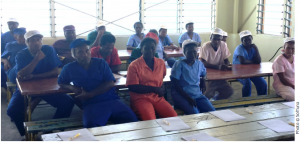
1 Launched at the World Economic Forum in 2011, the EDGE methodology triangulates these sources of information to examine the alignment and gaps between them, so that a more holistic and effective gender-equality strategy can be designed and implemented. EDGE allows companies to benchmark themselves against global market players, including 2,500 companies listed in the Dow Jones Sustainability Index. The EDGE gender certification can only be granted by an approved third-party auditing and certification body. The EDGE Certified Foundation is currently working with more than 100 companies in 31 countries and 21 industries.
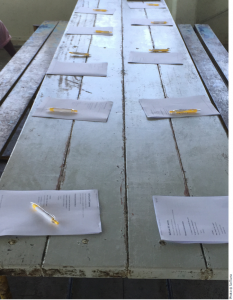
FINDINGS FROM DATA ANALYSIS
All of the data sources were analyzed individually and in relation to one another, to give SolTuna management a comprehensive understanding of the key issues facing women workers, as well as some potential entry points for taking action. Key results of the data analysis are presented below.
RESULTS OF GENDER-EQUALITY BENCHMARKING
Women comprise the majority of SolTuna’s workforce – approximately 1,200 out of around 1,800 staff. However, women are highly concentrated at the operational level and significantly under-represented across all levels of management. Women make up 67% of all operational staff, but this share reduces significantly at junior management level (26%), middle management (14%), upper management (0%), and top management (20%). This puts SolTuna above the global industry peer group average for the share of women in the total workforce, but below the industry peer group average for the share of women in management positions. SolTuna also has an entirely male board of directors. While the proportion of female managers is relatively low from a global perspective, it is notable among businesses in the region, with many women in positions of authority in the Quality Assurance and Sanitation Department. Furthermore, women in senior management, including one of two shift production managers and the Quality Control and Sanitation Manager, perform business-critical roles.
The majority of SolTuna staff surveyed believe that gender equality is important for SolTuna to remain competitive in the market. Yet there are opportunities for this commitment to be more fully reflected in relevant policies and practices. For e xample, gender is not reflected in the performance measures of any managers. Similarly, while the company does take gender into consideration for succession planning in some key leadership positions, it does not yet use gender-sensitive language or visuals in job advertisements or conduct any awareness training on potential gender bias. While the company has proactively looked to hire women into non-traditional jobs, there are no set targets or objectives for the gender composition at management level. In addition, based on responses to the recent diagnostic, SolTuna plans to review its policy and approach on workplace safety and employee conduct, including strengthening the procedure for reporting and recording grievances.
xample, gender is not reflected in the performance measures of any managers. Similarly, while the company does take gender into consideration for succession planning in some key leadership positions, it does not yet use gender-sensitive language or visuals in job advertisements or conduct any awareness training on potential gender bias. While the company has proactively looked to hire women into non-traditional jobs, there are no set targets or objectives for the gender composition at management level. In addition, based on responses to the recent diagnostic, SolTuna plans to review its policy and approach on workplace safety and employee conduct, including strengthening the procedure for reporting and recording grievances.
It is clear that the process of undertaking the diagnostic raised awareness among SolTuna employees and management. A number of male managers wrote comments in response to the survey calling for more attention to hiring, training, and promoting more women at senior levels, so that the management better reflects the overall employment demographics.
Going forward, SolTuna plans to strengthen performance-management systems with greater attention to creating more opportunities for women to move into different roles. Formal education requirements for certain jobs may be an unnecessary barrier that can be reconsidered, especially in light of the educational system in the Solomon Islands that can fail to reach and adequately educate students that are many past primary levels.
UNDERSTANDING ABSENTEEISM AND TURNOVER
IFC analyzed attendance data for all SolTuna employees for the period January 1–September 11, 2015, to identify and catalog reasons for absenteeism. Further analysis was conducted using a range of demographic indicators, such as age, home island, tenure, and gender, for a subset of employees, with a sample size of 1,200–1,350 (the sample size varied depending on the demographic metric).
LEVELS OF ABSENTEEISM
Like many other employers in Solomon Islands and tuna processors across the Pacific, SolTuna experiences extremely high absenteeism rates among production staff, with staff absent 32% of the time on average. A portion of absenteeism is accounted for by statutory and pre-approved forms of leave such as maternity leave, holiday leave, or approved sick leave. This type of leave accounts for 14% of workers’ absenteeism on average. Under Solomon Islands’ law, women are entitled to a minimum of six and up to 12 weeks of maternity leave, paid at 25% of their salary, and to two one-hour breaks when nursing. Paternity leave is not provided for under the law.
A significant percentage of leave, however, is taken without permission. The analysis focused on this type of discretionary or ‘controllable’ leave. On average, workers are absent for unexcused and unknown reasons 18% of the time. Reducing the level of this controllable absenteeism could significantly improve SolTuna’s productivity and cut staffing costs. Those absent without permission are not paid for days they do not work, but the absence of a reliable workforce causes SolTuna to employ far more workers than would be necessary and this entails significant fixed costs. Currently, the company overstaffs each shift to account for this absenteeism. Controllable absenteeism is the focus of the following analysis:
There is a clear pattern of higher absenteeism at the beginning and end of each week, with 20% absenteeism on Mondays and Fridays, dropping to 17% on Tuesdays and 16% on Wednesdays and Thursdays. Staff are also significantly more absent on paydays and the days either side, with controllable absenteeism of 29% on average on payday, 24% the day before, and 31% the day after. There are also clear patterns by department (see graph below). Skinners (23%), Loinners (19%), Butchering (19%), and Packing (15%) have the highest rates of absenteeism, while Fish Meal, Time-keeping, and Operations have the lowest rates (3%).

WHO IS MOST ABSENT?
Further analysis using demographic data identified that absenteeism is not equal across employees. Some 20% of employees are responsible for 50% of controllable absenteeism. The most absent workers are young, married, and local women, who are absent around 24% of the time on average. The least absent are married men over 30 who have above-average education and whose home islands are further away (3% absenteeism). Single women over 30 with less education are also among the least absent (10% absenteeism). These results, coupled with information obtained through focus groups and the mini-study on absenteeism, suggest that, to some extent, absenteeism is related to care responsibilities of younger women who have children and are living with family.
Absenteeism rates tend to drop as workers get older, with younger workers significantly more absent: workers under the age of 25 are absent 21% of the time on average, compared to 14% for 30- to 35-year-olds, and only 7% for those above 50. Longer tenure also tends to reduce absenteeism, but only after staff have been with the company for some time. Staff with less than one year and up to five years of tenure are absent between 19% and 17% of the time respectively. By the time staff have been with the company for more than seven years, absenteeism drops to around 9%. This is likely also a feature of age, and the reduced likelihood of having below school-aged children at home. Where workers come from also impacts their rate of absenteeism, with workers from closer islands being more absent.
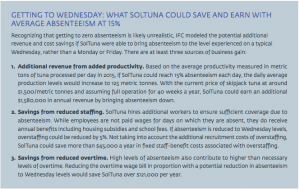
WHY WORKERS ARE ABSENT
Absenteeism is persistent for both male and female staff. However, in diving deeper into the causes of absenteeism, it is clear that gender-related issues and gender roles are a significant factor. By triangulating data from the EDGE gender assessment and the demographic analysis discussed above, as well as the results of a study tracking reasons for absenteeism over a four-week period and focus groups with staff, the following were identified as major contributors to the high rates of absenteeism and turnover among SolTuna production workers:
1. Poor worker and family health, including due to poor community water and sanitation, and high rates of GBV;
2. Lack of quality childcare; and
3. The need for immediate cash, including low financial literacy and insufficient savings.
The primary reasons for production-worker absenteeism were recorded during a four-week period in August– September 2015 (see chart below). During this period, over half all absenteeism was health-related, either a result of the worker’s own illness (23% sick without a certificate and 15% sick with a certificate), or time needed to care for a sick child or family member (15%). An additional 16% of absences were due to problems with transportation, which focus groups suggest includes staff missing transportation because they slept late or were hungover. In focus groups, workers reported tiredness due to working long hours and late nights as one of their biggest challenges.
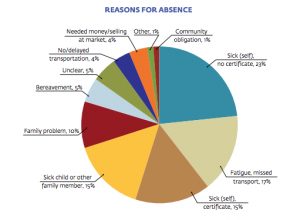
A significant share of workers also indicated they were absent (10%) or resigned (15%) due to family problems. Many workers reported that family problems, including physical violence, threats, and other forms of domestic violence, affect their ability to get to work and to work productively when they are there. Laws against domestic violence and sexual assault were passed only in 2015 and 2016 respectively, so legal remedies are new and may not always be available. Noting the dearth of services available, SolTuna has actively supported the development of a safe house in the town and has sent many staff to be trained as peer counselors in order to support their colleagues, family members, and neighbors facing violence. In cases where they are requested to do so by staff, SolTuna management may intervene to help, which may include bringing in the police.
In focus groups, workers discussed other concerns they had about the workplace that had not been directly cited as reasons for absence, but which may play a role in weakening employee engagement. These included concerns about male workers’ ‘horseplay’ on the shop floor and safety concerns such as slips and falls or cuts. SolTuna is responding with increased training on equipment and emergency preparedness, as well as adding expertise and staff to address OHS concerns.
ANALYZING TURNOVER
SolTuna does not always receive advance notice when workers leave their jobs, but in some cases they receive a resignation letter. A review of 26 resignation letters received by SolTuna between January and June 2015 found that more than one-quarter (26%) of all workers who provided a letter resigned to care for elderly family members, while almost 23% resigned for health- or illness-related reasons. A further 18% of resignations were to care for children (see chart below). Two workers cited working conditions as reasons for resignation, one being bothered by the smell and another reported being cold.
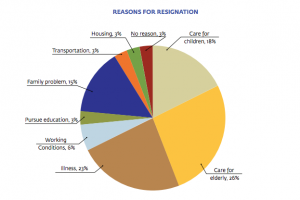
MEASURES SOLTUNA IS TAKING
In light of the analysis undertaken on the root causes of absenteeism and turnover, SolTuna has launched a number of initiatives and reforms, and has more planned. For example, SolTuna has tightened its response to chronic absenteeism, ensuring HR records and attendance are closely monitored. As discussed, the company has also raised wages for the bottom tier of earners, increasing the incentive to come to work regularly and keep their jobs.
THE NEXT FRONTIER FOR SUPPORTING WOMEN WORKERS AT SOLTUNA
The financial-literacy course will be rolled out to the remaining SolTuna workers and is expected to significantly improve worker perceptions about their pay, resulting in greater loyalty and attendance. Other improvements to worker–management dialogue, such as the changes discussed above related to the SECC, are expected to have similar results.
These efforts are already paying off for SolTuna, with dramatically reduced absenteeism rates in 2016 compared to 2015. Total absenteeism between January and May 2016 was 18%, compared to 32% for the same period in 2015, and controllable absenteeism reduced substantially from 16% in 2015 to 12% in 2016.
Going forward, additional incremental reduction in absenteeism may well be tougher to achieve, but there are further avenues to pursue. Four are discussed below: healthcare, GBV, childcare, and expanding career pathways. As previously discussed, poor worker and family health is a key driver of absenteeism at SolTuna, with 23% of absences due to sickness where no medical certificate was provided, a further 15% due to sick leave with a medical certificate, and 15% related to caring for sick children or family members. Almost one quarter (23%) of resignations were also due to illness. During focus groups, staff emphasized water and sanitation as a major concern, especially for those with young children and those living in private accommodation.
SolTuna is developing plans on worker healthcare initiatives, even though the company is in less direct control of many health factors. To date, the company has analyzed the most frequent complaints at its health clinic and identified a prioritized list of health issues to target with community and workplace campaigns. It is considering other options for partnering with government or non-government organizations to conduct a deeper study on community health and then develop cost-effective implementation plans to help address the causes of poor health. A likely target of this work will be efforts to improve access to clean water and sanitation. Another top priority is likely to be reproductive health services.
A related driver of absenteeism is family. Some 10% of absenteeism was reportedly due to family problems, while 15% of resignation letters reported family problems as the primary reason for leaving SolTuna. During focus groups, women reported family problems having a range of impacts on their work, including partners restricting their ability to go to work and issues arising when they return home late after working overtime or on the night shift.
While the company has already invested in supporting the development of a safe house in the community, as well as sponsored training for staff members in peer counseling, the company has yet to establish a structured approach and policy for how it addresses domestic violence among its staff, in terms of the support that could be offered to victims of violence. Implementing a policy and associated training on GBV as a workplace issue could bring various benefits to the company (see box below). A model policy road-tested in several Papua New Guinea businesses will be adapted for use at SolTuna.
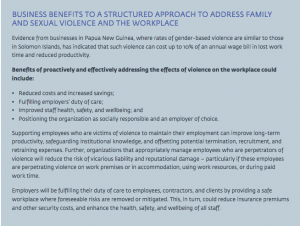
Finally, SolTuna will continue to invest in getting more women into non-traditional jobs, and launch a targeted effort to improve female representation at management levels to capitalize on the benefits of a more diverse leadership team.
SolTuna has firmly embraced the business case for investing in its female workforce and is taking clear steps toward implementing an effective strategy for supporting women as employees and leaders across the organization. The proactive approach that SolTuna is taking on issues such as GBV and training staff on financial literacy are positioning it as a clear leader, not only in Solomon Islands but across the Pacific region. SolTuna and IFC will continue to monitor progress in all the areas outlined above to enable continual improvements and to identify those areas with the greatest impact for both women and the company.
SOURCES
Brown, Drusilla; Domat, George; Veeraragoo, Selven; Dehejia, Rajeev; Robertson, Raymond, 2014, Are Sweatshops Profit-Maximizing? Answer: No. Evidence from Better Work Vietnam, Better Work Discussion Paper no.17: http://betterwork.org/global/?p=7342
Darko, E., Smith, W. and Walker, D, 2015, Gender Violence in Papua New Guinea: The Cost to Business, Overseas Development Institute, August: https://www.odi.org/sites/odi.org.uk/files/odi-assets/publications-opinionfiles/9886.pdf
EDGE: http://www.edge-cert.org/
Harorimana, D, 2012, “Job Creation in the Tuna Industry of the Solomon Islands – A Tentative Strategic analysis”. https://works.bepress.com/knowledgeispower/23/
IFC, 2016. “SheWorks: Putting Gender-Smart Commitments into Practice. At the Workplace.” www.ifc.org/ sheworks
International Labor Organization, 2015, Eliminating sexual harassment in workplaces in the Pacific: http://www. ilo.org/wcmsp5/groups/public/—asia/—ro-bangkok/—ilo-suva/documents/policy/wcms_407363.pdf
SINSO, 2009a, Report on Economic Activity and Labour Force. Honiara: Solomon Islands Government, Solomon Islands National Statistics Office.
SPC, 2009. Solomon Islands Family Health and Safety Study: A study on violence against women and children. Noumea: Secretariat of the Pacific Community (SPC).
World Bank Group, 2016, Women, Business and the Law: http://wbl.worldbank.org/
STAY CONNECTED
WEB: www.ifc.org/gender
LINKEDIN: www.linkedin.com/company/ifc-agribusiness
TWITTER: @WBG_Gender




